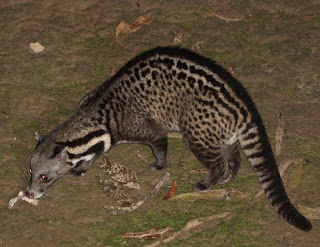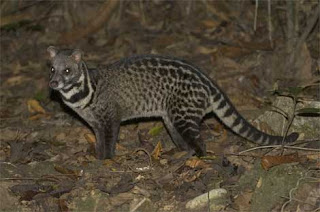Animal Wildlife | Malayan Civet | The Malayan civet (also known as the Oriental civet) is a species of civet natively found across the Malaysian Peninsula and on a number of the islands that surround it.The Malayan civet is one of the most distinguishable species of civet due to it's dark legs,and the spot-like markings that form stripes along it's body.The Malayan civet is found inhabiting the tropical jungles and rainforests throughout mainland Malaysia and is also found on a number of the large tropical islands close by including the PhilippinesBorneo and Sumatra. Unfortunately,Malayan civets have been drastically affected by increasing deforestation (and therefore habitat loss) in their native regions.
The Malayan civet is widely spread and fairly commonly found throughout much of South-East Asia and despite their cat-like appearance and behaviours, civets are not felines at all but are in fact more closely related to other small carnivores including weasels and mongooses. One of the Malayan civets most distinctive features is its long tail which is marked by up to 15 black bands and is actually thought to provide the Malayan civet with more camouflage in the jungle. The Malayan civet is solitary animal that only comes out under the cover of night to hunt and catch food. These nocturnal animals are primarily ground-dwelling, foraging for rodents on the forest floor, although the Malayan civet is known to climb up into the trees either in search of food or to hide from approaching predators.
The Malayan civet is a carnivorous animal, and like other species of civet, it survives on a purely meat-based diet. Small animals such as rodents, lizards, snakes and frogs make up the majority of the Malayan civet's diet, along with insects and other small creatures scuttling through the under-growth. Despite being a secretive yet relatively ferocious carnivore, the Malayan civet is actually preyed upon by a number of predators within their natural environment. Large predatory cats are the most common predators of the Malayan civet including tigers and leopards along with reptiles such as large snakes and crocodiles.
The female Malayan civet usually gives birth to up to 4 young after a gestation period that lasts for a couple of months. The babies are weaned by their mother until they are strong enough to fend for themselves. Malayan civets can live for up to 20 years, although most rarely get to be this old. Today, the Malayan civet is under threat from deforestation and therefore drastic loss of much of its natural habitat. The main reason for such extensive deforestation in the area is either for logging or to clear the land to make way for palm oil plantations.






Oh Very cute. Thanks for update... Brochure Printing and Web 2 Print Solution
ReplyDelete